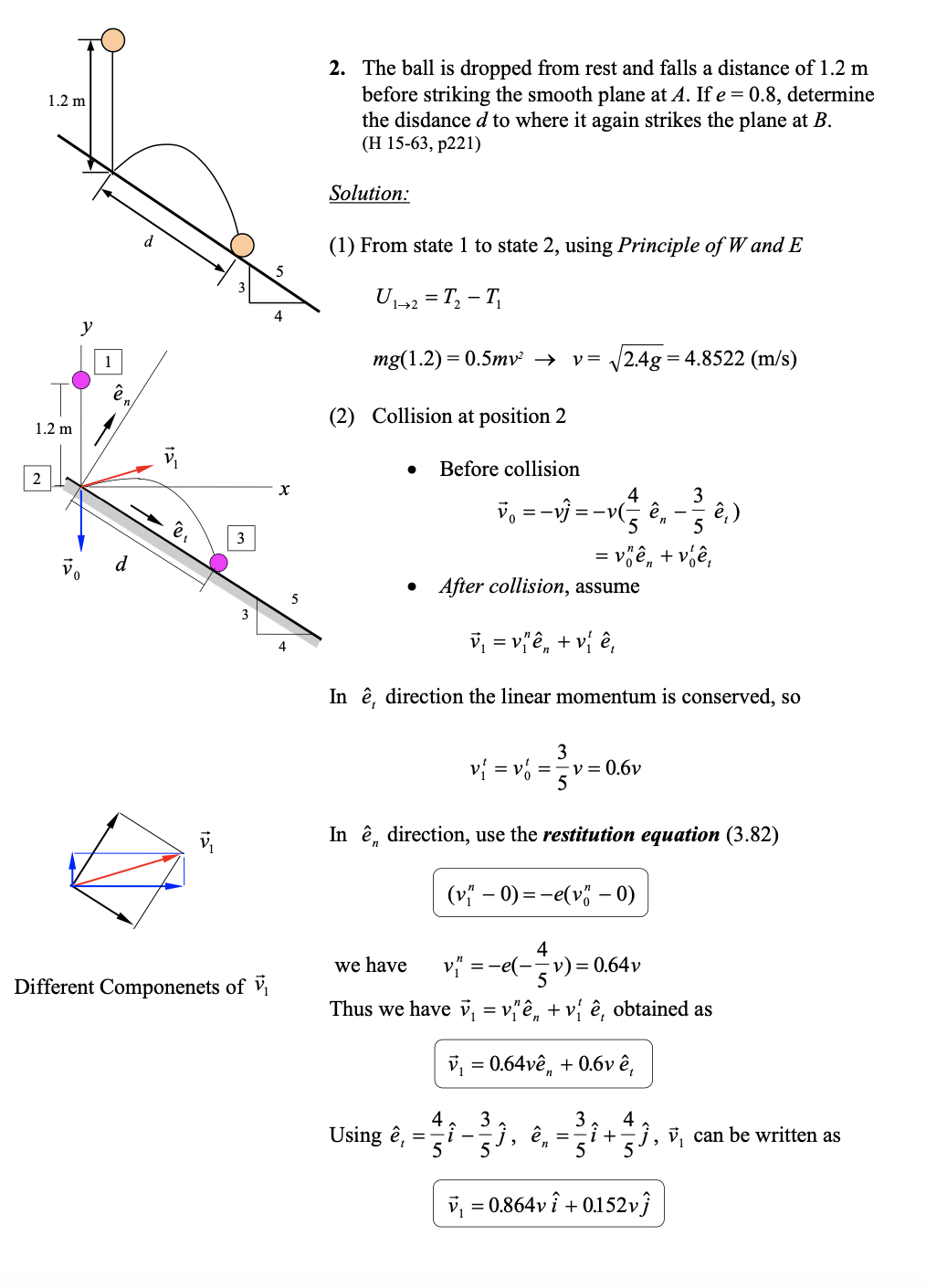2. The ball is dropped from rest and falls a distance of 1.2 m before striking the smooth plane at A. If e = 0.8, determine the disdance d to where it again strikes the plane at B. (H 15-63, p221) Solution:
2. The ball is dropped from rest and falls a distance of 1.2 m before striking the smooth plane at A. If e = 0.8, determine the disdance d to where it again strikes the plane at B. (H 15-63, p221) Solution:
Elements Of Electromagnetics
7th Edition
ISBN:9780190698614
Author:Sadiku, Matthew N. O.
Publisher:Sadiku, Matthew N. O.
ChapterMA: Math Assessment
Section: Chapter Questions
Problem 1.1MA
Related questions
Question
Why is et = 4/5 i - 3/5 j and en = 3/5 i + 4/5 j .
Finding it hard to visualise, are u able to draw it out and derieve it?
I just need to know how to derive et and en

Transcribed Image Text:2. The ball is dropped from rest and falls a distance of 1.2 m
before striking the smooth plane at A. If e = 0.8, determine
the disdance d to where it again strikes the plane at B.
(Н 15-63, р221)
1.2 m
Solution:
(1) From state 1 to state 2, using Principle of W and E
U1-2 = T, – T,
y
mg(1.2) 3 0.5mту' >
v= /2.4g = 4.8522 (m/s)
1
(2) Collision at position 2
1.2 m
Before collision
2
4
=-v(-
3
v, = -vŷ
ê,
ê,)
in
5
3
= vê, + vê,
After collision, assume
d
5
v, = v"ê, + v{ ê,
In ê, direction the linear momentum is conserved, so
3
vi = vó = 5"
v = 0.6v
In ê, direction, use the restitution equation (3.82)
(v" – 0) = -e(v" – 0)
4
we have
v =-e(--v)= 0.64v
5
Different Componenets of V
Thus we have i, = v" ê, + v{ ê, obtained as
v, = 0.64vê, + 0.6v ê,
3
Using ê,
5
j, ê,
+
v, can be written as
%3D
v, = 0.864v î + 0.152vĵ
Expert Solution
This question has been solved!
Explore an expertly crafted, step-by-step solution for a thorough understanding of key concepts.
This is a popular solution!
Trending now
This is a popular solution!
Step by step
Solved in 2 steps with 2 images

Knowledge Booster
Learn more about
Need a deep-dive on the concept behind this application? Look no further. Learn more about this topic, mechanical-engineering and related others by exploring similar questions and additional content below.Recommended textbooks for you

Elements Of Electromagnetics
Mechanical Engineering
ISBN:
9780190698614
Author:
Sadiku, Matthew N. O.
Publisher:
Oxford University Press

Mechanics of Materials (10th Edition)
Mechanical Engineering
ISBN:
9780134319650
Author:
Russell C. Hibbeler
Publisher:
PEARSON

Thermodynamics: An Engineering Approach
Mechanical Engineering
ISBN:
9781259822674
Author:
Yunus A. Cengel Dr., Michael A. Boles
Publisher:
McGraw-Hill Education

Elements Of Electromagnetics
Mechanical Engineering
ISBN:
9780190698614
Author:
Sadiku, Matthew N. O.
Publisher:
Oxford University Press

Mechanics of Materials (10th Edition)
Mechanical Engineering
ISBN:
9780134319650
Author:
Russell C. Hibbeler
Publisher:
PEARSON

Thermodynamics: An Engineering Approach
Mechanical Engineering
ISBN:
9781259822674
Author:
Yunus A. Cengel Dr., Michael A. Boles
Publisher:
McGraw-Hill Education

Control Systems Engineering
Mechanical Engineering
ISBN:
9781118170519
Author:
Norman S. Nise
Publisher:
WILEY

Mechanics of Materials (MindTap Course List)
Mechanical Engineering
ISBN:
9781337093347
Author:
Barry J. Goodno, James M. Gere
Publisher:
Cengage Learning

Engineering Mechanics: Statics
Mechanical Engineering
ISBN:
9781118807330
Author:
James L. Meriam, L. G. Kraige, J. N. Bolton
Publisher:
WILEY